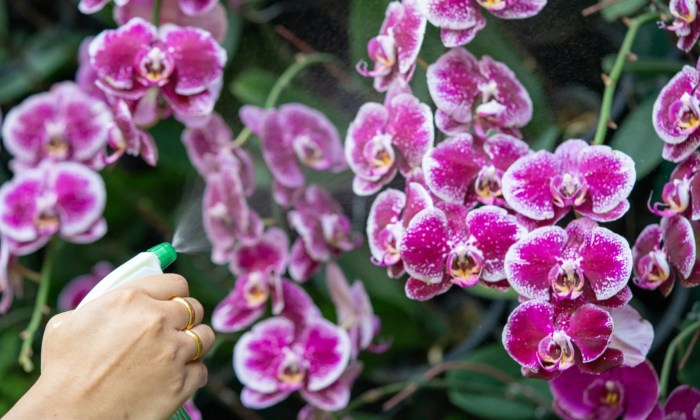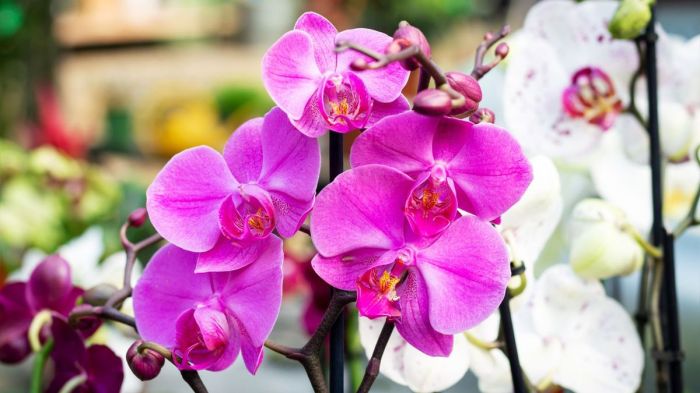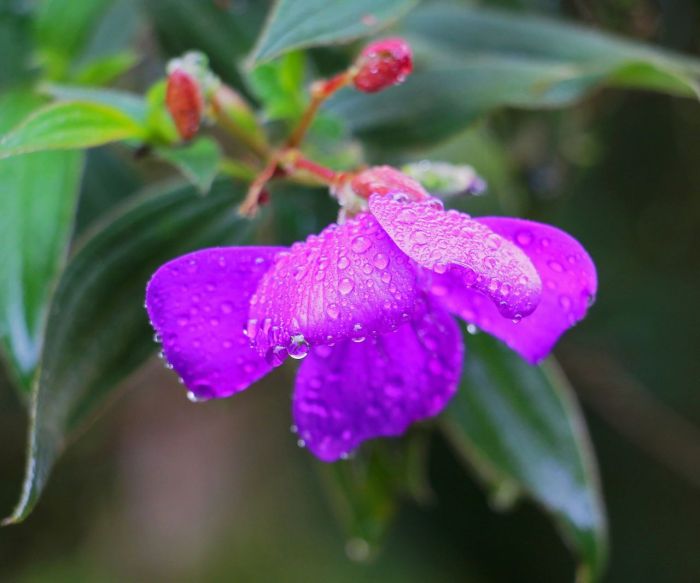How Much Water for Orchid Plant?
Watering Frequency for Orchids
How much water for orchid plant – Proper watering is crucial for orchid health and thriving. The frequency depends on several interconnected factors, ensuring you provide the right amount of moisture without overwatering or underwatering.
Factors Influencing Orchid Watering Needs
Several key factors determine how often you should water your orchids. These include the size of the pot, the season, the specific type of orchid, and the ambient humidity.
- Pot Size: Smaller pots dry out faster than larger ones, requiring more frequent watering.
- Season: Orchids need more frequent watering during warmer months (spring and summer) due to increased evaporation and higher growth rates. Watering frequency decreases in colder months (autumn and winter).
- Orchid Type: Different orchid species have varying water requirements. For example, Phalaenopsis orchids generally prefer less frequent watering than Cattleya orchids.
- Humidity: Higher humidity levels reduce the rate of water evaporation from the potting medium, thus decreasing the need for frequent watering.
Orchid Watering Schedule, How much water for orchid plant
This table provides a general guideline for watering orchids based on the factors discussed above. Remember to always check the potting medium’s moisture level before watering.
| Orchid Type | Pot Size | Watering Frequency (Summer) | Watering Frequency (Winter) |
|---|---|---|---|
| Phalaenopsis | Small (<6 inches) | Once a week | Every 10-14 days |
| Phalaenopsis | Large (6+ inches) | Every 7-10 days | Every 14-21 days |
| Cattleya | Small (<6 inches) | Every 5-7 days | Every 7-10 days |
| Cattleya | Large (6+ inches) | Every 7-10 days | Every 10-14 days |
| Dendrobium | Small (<6 inches) | Every 5-7 days | Every 7-14 days |
| Dendrobium | Large (6+ inches) | Every 7-10 days | Every 10-21 days |
Signs of Underwatering and Overwatering
Recognizing the signs of both under- and overwatering is crucial for maintaining healthy orchids. Leaf appearance and root condition provide clear indicators.
- Underwatering: Leaves become shriveled, wrinkled, and may appear dry and brittle. The potting medium feels completely dry to the touch. Roots may appear shrunken and silvery-gray.
- Overwatering: Leaves may yellow, become soft or mushy, and may develop brown spots or lesions. The potting medium remains consistently soggy. Roots may turn brown, mushy, and have a foul odor, indicating root rot.
Water Quality and Orchid Health: How Much Water For Orchid Plant

Source: brilliantorchids.com
The quality of water used for irrigation significantly impacts orchid health and growth. Different water sources have varying mineral content and chemical compositions, influencing the plant’s ability to absorb nutrients and resist diseases.
Impact of Different Water Sources
Tap water, filtered water, and rainwater each have distinct effects on orchids. Tap water often contains chlorine and minerals that can harm delicate orchid roots. Filtered water removes many impurities but may still contain some minerals. Rainwater is generally considered the best option, being naturally soft and free from chlorine and most minerals. However, rainwater can also vary in its mineral content and pH level, depending on the local environment.
Issues Caused by Poor Water Quality

Source: futurecdn.net
High mineral content in water can lead to salt buildup in the potting medium, hindering nutrient absorption and potentially damaging roots. Chlorine can burn orchid roots and negatively affect overall plant health. Excessive fluoride can also cause leaf tip burn.
Preparing Suitable Water for Orchids
Ideally, use rainwater. If rainwater isn’t accessible, let tap water sit for 24 hours to allow chlorine to dissipate. Consider using a water filter to remove minerals and other impurities. Always ensure the water is at room temperature before watering.
Watering Methods for Orchids
Several methods exist for watering orchids, each with its own advantages and disadvantages depending on the orchid type and potting medium.
Comparison of Watering Methods
Top watering, bottom watering, and soaking are common methods, each offering distinct benefits and drawbacks.
- Top Watering: This involves gently pouring water over the potting medium until it drains from the drainage holes. It’s simple but can sometimes lead to overwatering if not carefully monitored.
- Bottom Watering: This involves placing the orchid pot in a tray of water and allowing the roots to absorb water from the bottom. This method is excellent for preventing overwatering and allows for more even moisture distribution.
- Soaking: This involves completely submerging the pot in a bucket of water for a few minutes, then allowing it to drain thoroughly. This is effective for thoroughly hydrating the potting medium but should be done less frequently to avoid overwatering.
Step-by-Step Watering Guides
Here are step-by-step instructions for each method:
- Top Watering:
- Gently pour lukewarm water over the potting medium, ensuring the entire surface is moistened.
- Allow excess water to drain completely from the drainage holes.
- Discard any standing water in the pot’s saucer.
- Bottom Watering:
- Fill a tray with lukewarm water to a depth of about an inch.
- Place the orchid pot in the tray, ensuring the water level doesn’t reach the top of the pot.
- Allow the pot to sit in the water for 30 minutes to an hour, or until the top inch of the potting medium feels moist.
- Remove the pot from the tray and allow excess water to drain.
- Soaking:
- Fill a bucket with lukewarm water.
- Submerge the orchid pot completely in the water for 5-10 minutes.
- Remove the pot and allow excess water to drain thoroughly.
- Ensure the pot is not left sitting in standing water.
Orchid Potting Media and Watering
The type of potting medium significantly influences how frequently you need to water your orchids. Well-draining mixes are essential to prevent root rot.
Influence of Potting Medium on Watering

Source: futurecdn.net
Different potting mixes retain varying amounts of moisture. A mix that retains too much moisture can lead to overwatering and root rot, while a mix that dries out too quickly may cause underwatering.
Characteristics of Well-Draining Potting Mixes
Ideal orchid potting mixes are well-aerated and allow for excellent drainage. They typically consist of a blend of bark chips, perlite, charcoal, and sphagnum moss, providing a balance of moisture retention and aeration.
Comparison of Potting Mixes and Watering Requirements
| Potting Mix Type | Drainage Properties | Watering Frequency (Example – Adjust based on other factors) |
|---|---|---|
| Bark-based mix | Excellent | More frequent watering |
| Sphagnum moss-based mix | Good | Moderate watering |
| Coconut husk-based mix | Good | Moderate watering |
Troubleshooting Watering Issues
Incorrect watering practices can lead to several problems. Recognizing the symptoms and implementing corrective measures is crucial for orchid recovery.
Watering orchids correctly is crucial; overwatering is a common problem. The amount of water depends on factors like pot size and the orchid’s stage of growth. It’s important to remember that while water itself doesn’t directly provide oxygen, as explained in this article on does water provide plants with oxygen , proper watering ensures the roots can access the oxygen present in the air pockets within the potting medium.
Therefore, well-draining soil is essential for healthy orchid roots and appropriate hydration.
Common Watering Problems and Solutions
- Root Rot: This is characterized by mushy, brown roots with a foul odor. Remove affected roots, repot the orchid in fresh, well-draining medium, and adjust watering practices to prevent future occurrences.
- Leaf Yellowing: Yellowing leaves can indicate both overwatering and underwatering. Check the roots and potting medium to determine the cause. Adjust watering frequency accordingly and ensure good air circulation.
- Wilting: Wilting leaves usually indicate underwatering. Water thoroughly and monitor the plant’s recovery. Adjust watering frequency based on the plant’s response.
Assessing Orchid Root Health
Gently remove the orchid from its pot and inspect the roots. Healthy roots are firm, silvery-white, and have a healthy, slightly moist feel. Brown, mushy, or slimy roots indicate root rot and require immediate attention.
Environmental Factors and Watering
Temperature and humidity significantly influence orchid watering needs. Adjusting watering schedules based on these factors is essential for maintaining optimal plant health.
Influence of Temperature and Humidity
Higher temperatures and lower humidity increase the rate of water evaporation from the potting medium, requiring more frequent watering. Lower temperatures and higher humidity decrease evaporation, reducing the need for frequent watering.
Adjusting Watering Schedules
During hot, dry periods, increase watering frequency. During cool, humid periods, decrease watering frequency. Always check the potting medium’s moisture level before watering, regardless of the ambient conditions.
Environmental Factors Impact on Orchid Hydration
Imagine a visual representation: In a hot, dry environment, the potting medium dries out quickly, indicated by a visibly dry surface and shriveled leaves. The roots appear dry and shrunken. In a cool, humid environment, the potting medium retains moisture longer, the leaves are plump, and the roots are firm and healthy. The difference in watering needs is directly reflected in the plant’s appearance and the moisture level of the potting medium.
Question & Answer Hub
Can I use tap water for my orchids?
Tap water can be used, but ideally, let it sit out for 24 hours to allow chlorine to dissipate. Filtered or rainwater is preferred.
How do I know if my orchid needs water?
Check the potting mix; if it’s dry to the touch an inch or two below the surface, it’s time to water. Wilting leaves are also a sign of underwatering.
What should I do if my orchid has root rot?
Remove affected roots, repot in fresh, well-draining media, and adjust your watering schedule to prevent future issues.
My orchid’s leaves are yellowing; what could be the cause?
Yellowing leaves can indicate overwatering, underwatering, or nutrient deficiencies. Examine the roots and adjust your care accordingly.
How often should I fertilize my orchids?
Fertilize orchids sparingly, typically once a month during the growing season with a balanced orchid fertilizer diluted to half strength.




















